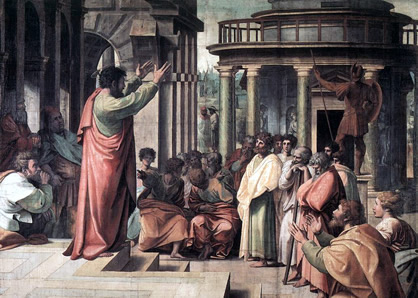Ecumenical Councils Turkey Second Council of Nicaea (787)
The Second Council of Nicaea was prompted not by a doctrine about the
nature of Jesus but by the iconoclastic controversy. It is the seventh
and the last of the councils which were recognized by both the Catholic
and Orthodox Churches.
This controversy began in the eighth century and gained strength in the
eastern lands
 of
the empire. Was it right to make painted or sculptured representations
of Jesus and the saints, and direct homage to such images? The defenders
of image worship claimed that if Jesus was really a man, it was logical
that he could be represented in visible form. When the Jews had been
forbidden to make images of God, the reason given (Ot 4: 12) had been
that they 'saw no form' of God.
of
the empire. Was it right to make painted or sculptured representations
of Jesus and the saints, and direct homage to such images? The defenders
of image worship claimed that if Jesus was really a man, it was logical
that he could be represented in visible form. When the Jews had been
forbidden to make images of God, the reason given (Ot 4: 12) had been
that they 'saw no form' of God.
In Jesus, however, God had shown Himself in visible form, and therefore
if the making of images was wrong, this was denying the Incarnation. The
Monophysite East thought that the humanity of Christ was inseparable
from his divinity and the effort to represent the aleptos, or
incomprehensible, was useless. The drawing of Jesus' image was trying to
separate his humanity from the divinity. The conflict over images
remained as a doctrinal argument until in 726 Leo III (717 -41), known
as the 'Isaurian' (from Germanicia, Mara) enforced Iconoclasm. The
reason for his attack on images is not clear. He may have wanted to
insure the support of his army which was mostly recruited from Anatolia
where iconoclastic belief was strong, influenced by Judaism and Islam.
His edict enforced the removal of all the icons from churches. The
controversy which he began lasted for over a hundred years and
contributed to the alienation of the Byzantine Church from that of Rome.
The iconoclastic policy of the State continued through the reigns of his
successors Constantine V (741-45) and Leo IV (775-80). The destruction
of images, eikons, lasted until the succession of Irene (780-97) upon
her husband's death, as regent for her infant son Constantine VI. Irene
was a zealous iconodule and wanted to restore the holy images.
However, much of the army was still iconoclast and she moved with
caution. She decided to summon a Second Council of Nicaea. It was held
in the church of St. Sophia, whose restored ruins still survive. Among other things this council declared that icons
deserved reverence (Greek proskynesis) but not adoration (Greek lalreia)
which was due to God alone and condemned the iconoclasts. This statement
was confirmed by Pope Adrian I, but partly because of an incompetent
translation it was not acceptable generally in the West.
still survive. Among other things this council declared that icons
deserved reverence (Greek proskynesis) but not adoration (Greek lalreia)
which was due to God alone and condemned the iconoclasts. This statement
was confirmed by Pope Adrian I, but partly because of an incompetent
translation it was not acceptable generally in the West.
For instance, the two words, proskynesis and lalreia, were equated in
translation so it appeared that the council ordered Christians to
worship icons in the same way they worshipped God. With this council the
division between Rome and Constantinople, which had been stimulated by
the Fourth Ecumenical Councils in Chalcedon (451) became complete, the
Roman Catholic Church and the Eastern Orthodox Church each going its own
way.
The political and economic failures of Irene and her successors caused a
reaction in favor of iconoclasm again from 814 until 843. The iconophile
cause was meanwhile being maintained by the monks of the monastery of
Studios at Constantinople under their abbot Theodore (759-826).
The empress Theodora, who ruled as regent for Michael III, after the
death of her iconoclast husband Theophilos (829-42) summoned a First
Council of Constantinople, which reaffirmed the rulings of the Seventh
Ecumenical Councils of 787 and on the first Sunday in Lent 843 restored
the icons for the last time with a procession in St. Sophia that has
come to be known as 'the Triumph of Orthodoxy.' Although not popular
with the multitude the iconoclast emperors were successful soldiers and
without them the life of the Byzantine empire might have been shorter.
Ecumenical Councils Turkey
First Council of Nicaea
(325)
First Council of Constantinople
(381)
Council of Ephesus
(431)
Council of Chalcedon
(451)
Second Council of Constantinople
(553)
Third Council of Constantinople
(680-1)
Second Council of Nicaea
(787)


